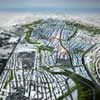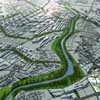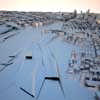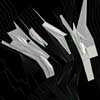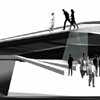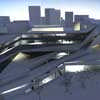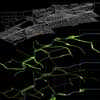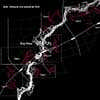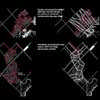Longgang buildings China, Architecture Competition Images, Design Contest, Architect, Pictures
Longgang City Design
Chinese Architecture Competition, Asia design by Groundlab Collective
20 Mar 2008
Deep Ground – Longgang City
Longgang Centre and longcheng Square International Competition
G r o u n d lab
Intro
Deep Ground project designed by Groundlab Collective, has recently won the design competition for Longgang Centre and Longcheng Square international competition.
The project deals with the regeneration of 11.8 Km2 of the urban fabric in the centre of Longgang, north east of Shenzhen in the Pearl River Delta, with estimated population of 350,000 and 9,000,000 m2 of new development.
The design of the project is strongly based in the methodology currently proposed by Landscape Urbanism, ranging from spatial concepts such as thickened ground, bottom up approach to reading the territory and deployment a relational urban design models. Collaborators for the competition stage include Arup ILG providing input in the infrastructure and InGame as local office.
Thickened ground
This concept describes the spatial strategy that Groundlab has used for the implementation of the underground development in conjunction with public space design and the river crossing. Central to the definition of the figure ground is an attempt to understand and design the space as a surface which acquires thickness and spatial complexity as the different programs and land uses start to combine. In this way, the thickened ground looks for mixture of programs rather than compartmentalization of functions, working towards and open ended spatial result which combines good quality open space with otherwise isolated infrastructural elements.
For the case of this project, the thickened ground emerges out of the bridge over the Longgagn river, crossing north to LongCheng Square to then become a folded surface containing both public programme, underground access and parking for the CBD. The thickened ground becomes a whole strategy to challenge the traditional opposition building vs landscape, managing to introduce surprisingly high density and programme into areas which are currently under used, increasing the overall value, open space usage and intensity of life at street level.
Landscape
Longgang River is located at the heart of Longgang city but is radically separated from the it with no interaction or relation apart from being used as a back yard and wastewater sewer The infrastructural landscape project used this contradictory condition to propose the recovery of the river triggering the revitalization not just of banks and surrounded areas but of the whole city , driving the landscape strategy, greenery and river as one interactive and interconnected system.
The infrastructure designed along the river will serve as an anchor point to deploy cleansing strategies, rainwater collection and flooding defence while creating green areas, ecological corridors, public open spaces, sports fields and leisure areas. The landscape network creates a major framework to articulate the urban fabric, the public areas and the infrastructural equipment of the city and will be able to generate a great variety of programmes which do not exist or are in poor conditions, linking the river to the neighbourhoods and with the city. This in fact will generate ecology inside the city, highlighting the presence of the river in the city not just as an aesthetic element but as a strategic, active and vital for the present and future viability of the city.
The design for the infrastructural landscape incorporates a number of principal elements: River and waterscapes, ecological corridors, river valleys, as well as others in relation with them: biodiversity, connectivity, use and activity and character. These elements are combined to produce an inspiring, hardworking, accessible, safe, sustainable and contemporary landscape.
Urban Villages
The concept of the urban villages is key in the project, as is an urban typology which clearly defines the character and history of many cities in China and Longgang in particular. There is a set of urban villages which have been identified as potentially interesting to be preserved. The project proposes the use of these areas as part of a strategy for generation of various brands across the site, providing certain characteristics and differentiation which will be the key for the success of the city as a whole.
Urban villages tend to show an extraordinary character which in many cases attracts visitors due to its distinctiveness. This is the case of the so called the Dafan Oil Painting Village, also in ShenZhen, where an industry of production of painting replicas has generated an unprecedented interest from tourists, which in turn has sparked the arrival of different kinds of artists and creative professionals.
In the case of this project, the villages show different characteristics which make them unique, like the presence of a market or prominent historical building. This fact is key in the management strategy of the urban villages as this can be an important point to anchor the urban life around them.
Parametric model
For the purposes of this project, a relational urban model has been created which can control simultaneously built mass quantities as well as 3D model of the built fabric. The model is based in sets of urban relationships which connect one another, hence the name of relational. One of the advantages of this working methodology is that it enables the generation of different options with a relative minor effort, as most of the drawing gets automatically produced, while there is potentially the chance to evaluate the overall built volume before the volume is even generated.
It also enables the combination of variables related to density with variables related to typology. This can be used to produce varied and diverse urban patterns with simple controls. The volumetry of the proposed built fabric shown in the final drawing and renderings has been modelled to suit the quantity of land use calculated in the Transport Chapter (around 9,000,000 m2).
The result of this work is a series of options which allow us to study simultaneously the effects of different massing options in terms of GFA (m2) and spatial arrangement as well. The image shows the type of iterations that the model allows to do, evaluating options where the centre of intensity of the model as well as the overall quantity of buildings are modified in order to get a totally different, yet related, urban configuration.
This leads to the concept of Adaptable Design applied for the Longgang masterplan, where changes on different variables (location and number of density nodes, particularities in building catalogue, etc) can be added into the design almost in real time so that further discussion on the urban fabric and architectural qualities can be put forward during the decision making process.
Location: China
China Architecture
China Architecture Design – chronological list
Chinese Architect – Design Practice Listings
Groundlab Team
Eva Castro, Eduardo Rico, Alfredo Ramirez, Holger Kehne, Sarah Majid
Competition Team:
Alejandra Bosch, Maria Paez, Brendon Carlin
Collaborators:
Clara Oloriz, Arturo Lyon, Enriqueta Llabres
Comments / photos for the Longgang Design Competition page welcome

